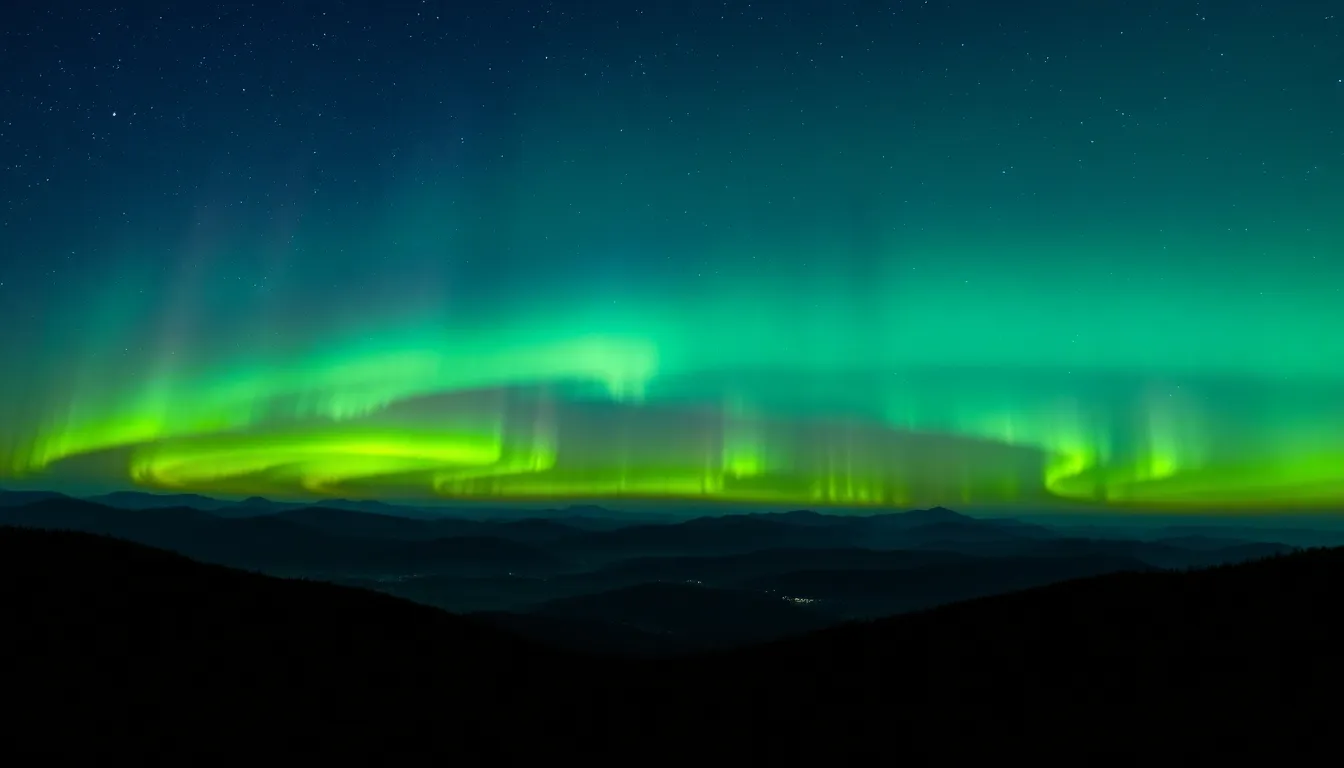The northern lights, or aurora borealis, are a breathtaking natural phenomenon that captivates stargazers and adventurers alike. Tonight, upstate New York offers a unique opportunity to witness this stunning display of colors dancing across the night sky. With the right conditions, the vibrant greens and purples can light up the darkness, creating a magical experience for those lucky enough to catch a glimpse.
As winter nights grow longer, the chances of spotting the northern lights increase, especially in regions away from city lights. Enthusiasts and curious onlookers can prepare for an unforgettable evening filled with wonder. Whether it’s a romantic outing or a family adventure, experiencing the northern lights in upstate NY is sure to leave lasting memories.
Table of Contents
ToggleOverview of Northern Lights
Northern lights, known as aurora borealis, result from solar wind interacting with Earth’s magnetic field. This phenomenon creates vibrant displays of color, primarily green, but sometimes pink, purple, and red.
Geographical locations significantly influence visibility. The best chances for seeing northern lights occur closer to the magnetic poles, although upstate New York provides suitable observation points, especially during winter months. Ideal conditions include clear, dark skies away from city lights.
Viewing times vary throughout the night, with optimal visibility occurring between 10 PM and 2 AM. Solar activity levels affect intensity and frequency. The NOAA Space Weather Prediction Center provides forecasts to help enthusiasts track potential displays.
Photographic opportunities abound, making this natural wonder attractive for both casual viewers and photography enthusiasts. Dress warmly, bring a camera, and select a location with minimal light pollution for the best experience.
Best Locations in Upstate NY

Upstate New York offers several prime locations for viewing the northern lights. Factors such as low light pollution and open skies enhance visibility, making these spots ideal for aurora sightings.
Popular Viewing Spots
- Adirondack Park
Adirondack Park, with expansive nature landscapes and minimal urban distractions, offers optimal viewing conditions. Many trails and lakes provide clear, unobstructed views of the sky.
- Watkins Glen State Park
Watkins Glen State Park features dramatic gorges and views that open up to the celestial canvas. The park’s elevated areas afford excellent perspectives of the northern lights, especially during winter.
- Saratoga Spa State Park
Saratoga Spa State Park combines natural beauty with spacious open areas. Visitors find ample opportunities to appreciate the auroras while enjoying the park’s thermal springs and scenic trails.
Hidden Gems
- Ticonderoga
Ticonderoga stands out with its remote location and vast dark skies. The nearby Lake Champlain provides stunning reflections of the northern lights, creating a picturesque setting.
- Crown Point
Crown Point, located along Lake Champlain’s shore, offers a tranquil atmosphere for aurora watching. The historical landmarks complement the natural scenery, enhancing the viewing experience.
- Glimmerglass State Park
Glimmerglass State Park, on the western shore of Otsego Lake, features expansive views and minimal light interference. The park’s natural setting allows for serene aurora sightings away from the bustling crowds.
Ideal Conditions for Viewing
Optimal conditions for viewing the northern lights in upstate New York rely on several factors, including weather, timing, and season.
Weather Considerations
Clear skies provide the best viewing experience for the northern lights. Cloud cover can obstruct visibility, making it crucial to check weather forecasts before planning an outing. Humidity and precipitation influence the clarity of the sky, where dry conditions boost the likelihood of a successful sighting. Windy weather can also clear clouds faster, increasing chances for observers. Local weather services, along with apps that provide real-time updates, can help pinpoint the ideal moment for viewing.
Timing and Seasonality
Timing plays a significant role in northern lights visibility. The hours between 10 PM and 2 AM often yield the most vibrant displays. The auroras are more likely during winter months, typically from late September through early April, due to longer nights and darker skies. Increased solar activity, which follows an 11-year cycle, raises the probability of visible auroras, making specific times more favorable for observation. Checking forecasts from the NOAA Space Weather Prediction Center can provide insights into solar activity levels and alert enthusiasts about the best times to view auroras.
Photography Tips for Capturing the Lights
Capturing the northern lights requires specific equipment and techniques for optimal results. Following the right strategies enhances photographic opportunities during this breathtaking phenomenon.
Equipment Recommendations
- Camera: Use a DSLR or mirrorless camera for manual control over settings. These camera types excel in low-light conditions.
- Lenses: A wide-angle lens (e.g., 14mm to 24mm) with a large aperture (f/2.8 or lower) captures more light and expansive views.
- Tripod: A sturdy tripod stabilizes the camera for long exposure shots, preventing blur from movement.
- Remote Shutter Release: This tool minimizes camera shake during exposure, allowing for clearer images.
- Headlamp: A headlamp with a red light setting helps navigate in the dark without affecting night vision.
Techniques for Stunning Shots
- Manual Settings: Focus on low ISO settings (800 to 1600) to minimize noise and select a slow shutter speed (10 to 30 seconds) to capture moving lights.
- White Balance Adjustment: Set the white balance to ‘daylight’ or manually adjust it around 3500K to enhance colors.
- Focus Properly: Manual focus on a distant light source or use live view to ensure clarity.
- Composition: Include foreground elements, such as trees or mountains, to add depth and context to the aurora.
- Patience: Wait for the aurora to fluctuate; it changes rapidly and may reveal new colors and patterns over time.
Experiencing the northern lights in upstate New York is a captivating adventure that shouldn’t be missed. With the right conditions in winter months and a little planning, anyone can witness this breathtaking display of nature. The beauty of the aurora borealis offers not just a visual feast but also a chance to create lasting memories with loved ones.
Whether it’s the expansive vistas of the Adirondacks or the serene reflections at Lake Champlain, each location provides a unique backdrop for this magical phenomenon. So grab a camera and bundle up for a night of wonder under the stars. The northern lights await, ready to leave an indelible mark on those fortunate enough to witness their splendor.



